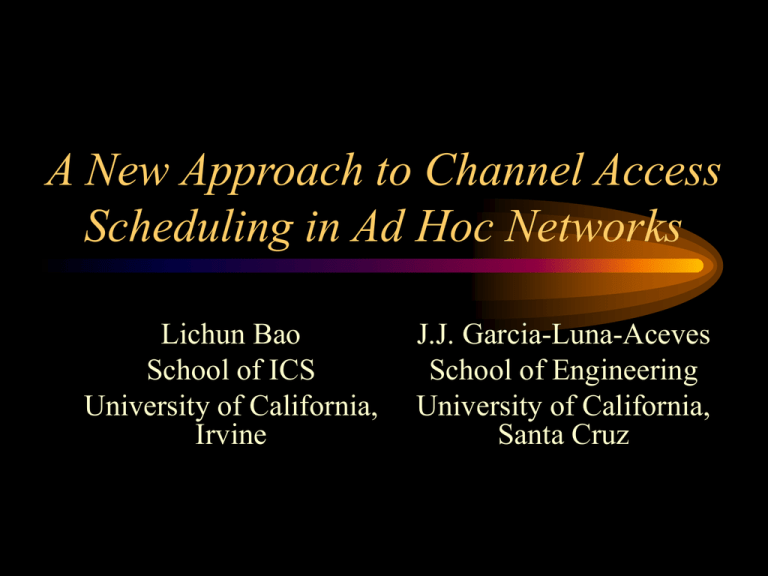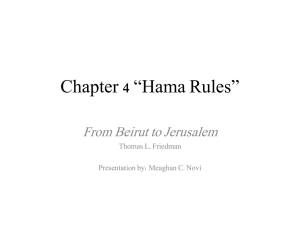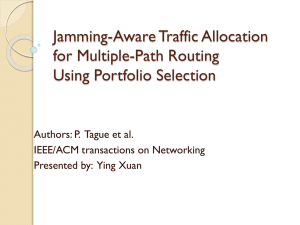A New Approach for Channel Access Scheduling in Ad Hoc Networks
advertisement

A New Approach to Channel Access
Scheduling in Ad Hoc Networks
Lichun Bao
School of ICS
University of California,
Irvine
J.J. Garcia-Luna-Aceves
School of Engineering
University of California,
Santa Cruz
Existing Solutions for
Channel Access:
• Random Access Scheme:
– ALOHA, CSMA/CA (FAMA, MACA,
MACAW, IEEE 802.11) : with/without
RTS/CTS handshakes.
– Difficulties providing fairness, QoS.
• Scheduled Access Scheme:
– Node/Link Activation.
– FDMA/TDMA/CDMA in multihop networks:
graph coloring problem — UxDMA.
University of California
2
Our Solution: Scheduled Access
• Problem description:
– Given a set of contenders Mi of an entity i in
contention context t, how does i determine
whether itself is the winner during t ?
• Topology dependence:
– Exactly two-hop neighbor information required
to resolve contentions.
– Two-hop neighbors are acquired by each node
broadcasting its one-hop neighbor set.
University of California
3
Example Settings:
•
•
•
•
•
Omni-directional Antenna;
Time slotted channel access;
Equal transmission range;
4 nodes;
Each node knows its one- and two-hop
neighbors — Mi.
University of California
4
Goals to Achieve:
• Collision-free — avoid hidden terminal
problem, no waste on transmissions;
• Fair — the probability of accessing the
channel is proportional to contention;
• Live — capable of yielding at least one
transmission each time slot.
University of California
5
Illustrations by Example:
i
j
l
k
0
i wins
1
j & l win
2
k wins
3
time t
University of California
6
Neighbor-aware Contention
Resolution (NCR):
• In each contention context (time slot t):
– Compute priorities
pkt Rand (k t ) k , k M i {i}
– i is the winner for channel access if:
j M i , p p
t
i
University of California
t
j
•
7
Attributes of NCR:
•
•
•
•
Collision freedom;
Fairness;
Liveliness;
2-coloring:
– An entity colors itself if it red has the highest
priority among its contenders.
– Otherwise, it has transparent color.
University of California
8
NCR-MI (Multiple Identities):
• Dynamic Resource Allocation.
• A node i may have Ii pseudo identities.
– k-th identity is denoted as i k .
– Ii is dynamically chosen by i according to
traffic requirement.
– Each identity of i gives i a chance to win a
contention. The more identities, the better
chance of channel access.
University of California
9
NCR-MI Specification:
• Compute the priority on each pseudo
identity of every contender:
– For l-th identity of contender k, we have:
t
pk l
Rand(k l t ) k l
k M i {i},1 l I k
• i is the winner for channel access one of its
priority is the greatest among its contenders.
•
University of California
10
Channel Access Probability:
• Dependent on the number of pseudo
identities and the density of the
neighborhood.
• Channel access probability:
– Bandwidth allocation
qi
Ii
kM {i} I k
i
University of California
11
Bandwidth Allocation Example:
• Channel access probability for individual
1
nodes:
1
3
j
4
i
1
4
1
3
l
k
• Spatial channel reuse ratio:
1 1 1 1
1.67
3 4 4 3
University of California
12
Delay & Throughput Analysis:
• Data packet service at entity i modeled as
M/G/1 queuing system with server vacation.
• Delay (Pollaczek-Kinchin formula):
i qi 2(1 qi ) 3
Ti
2(qi i )
2
• Throughput:
S min( k , qk )
k
University of California
13
Delay Curves:
University of California
14
Channel Access Scheduling
Protocols:
• Node Activation Multiple Access (NAMA):
– Entity type: node
– Time division:
•
•
•
•
Block
Section
Part
Time-slot
University of California
15
NAMA Time Division Illustrated:
Block
1
0
Section
0
.......
50
51
Membership Section:
Neighbor Maintenance
1
Part
0
Time Slot
1
2
University of California
16
NAMA Illustrated:
Fully connected network with 10 nodes. ID: 1~10.
Part 0
Part 1
1,5,6,8,10
2,3,4,7,9
1,10
5,8
6
4,9
2,3,7
2,3,4,7,9
Section 0
No occupied by anyone
Everyone tries to use
8
1,5,6
10
9
3
2,4,7
Section 1
Contenders resolve
contention using NCR
University of California
17
Neighbor Protocol:
• One-hop neighbor information
broadcasting.
– New node starting up.
– Link addition and deletion.
– Old neighbor going down can be treated as
multiple link deletions.
• Membership section: send signals.
University of California
18
Channel Access Scheduling
Protocols (continued):
• Link Activation Multiple Access (LAMA):
– Direct Sequence Spread Spectrum, available pseudonoise code set: Cpn
– Received-Oriented Code Assignment (ROCA)
ci c , k Rand (i) mod C pn
k
– Contenders of node i :
M i N ( N ) {i}
1
i
1
k
kn1i ,c
– Once Mi is decided, LAMA follows NCR.
University of California
19
LAMA Illustrated:
d 1
5
14
a
11
j
c
23
b
e 19
Node i tries to
activate its adjacent
links on code c
i
21
c
8
c
k
f 20
g
i can activate either
link (i,j) or (i,k).
6
University of California
Both j and k are
assigned code c
At time t, the priority
of each node is
computed.
20
Channel Access Scheduling
Protocols (continued):
• Pair-wise Link Activation Multiple Access
(PAMA):
– Contending entities are directed edges;
– Priorities are computed for each link;
– Dynamic code assignment:
cu c , k Rand (u t ) u mod C pn
k
– Contenders of a link are its adjacent links.
University of California
21
PAMA Illustrated:
a
13
5
b
23
i
7
c
c
k
14
21
11
f c
51
g
1. Directional links
2. Only one direction shown for simplicity
3. Hidden terminal avoidance: link (i,k) and (f,g) assigned
the same code — compare node priorities of i and f.
University of California
22
Summary — Unified Algorithm:
• Determine the entity type (node/link);
• Find out the contender set;
• Run NCR to determine if the entity is active
in the current time slot;
• Resolve hidden terminal problem.
University of California
23
Performance
(Delay — Fully Connected):
University of California
24
Performance
(Delay — Multi-hop Network):
University of California
25
Performance
(Throughput — Fully Connected)
University of California
26
Performance
(Throughput — Multi-hop)
University of California
27
Comparison with Static
Scheduling Algorithm (UxDMA):
University of California
28
Coloring Efficiency Comparison
with UxDMA:
University of California
29
Problems with NAMA
• Inefficient activation in certain scenarios.
– For example, only one node, a, can be activated
according NAMA, although several other
opportunities
exist.
4
10
8
a
b
1
f
7
g
6
c
5
d
e
3
h
—— We want to activate g and d as well.
University of California
30
Node + Link (Hybrid) Activation
• Additional assumption
– Radio tranceiver is capable of code division
channelization (DSSS —— direct sequence
spread spectrum)
– Code set is C .
• Code assignment for each node is per time
slot:
i .code = i .prio mod |C |
University of California
31
Hybrid Activation Multiple Access
(HAMA)
• Node state classification per time slot
according to their priorities.
– Receiver (Rx): intermediate prio among onehop neighbors.
– Drain (DRx): lowest prio amongst one-hop.
– BTx: highest prio among two-hop.
– UTx: highest prio among one-hop.
– DTx: highest prio among the one-hop of a
drain.
University of California
32
HAMA (cont.)
• Transmission schedules:
– BTx —> all one-hop neighbors.
– UTx —> selected one-hops, which are in Rx
state, and the UTx has the highest prio among
the one-hop neighbors of the receiver.
– DTx —> Drains (DRx), and the DTx has the
highest prio among the one-hops of the DRx.
University of California
33
HAMA Operations
• Suppose no conflict in code assignment.
• Nodal states are denoted beside each node:
– Node D converted from Rx to DTx.
– Benefit: one-activation in NAMA to four possible
activations in HAMA.
10-BTx
a
8-Rx
b
1-DRx
f
7-UTx
g
6-Rx
c
5-DTx
d
University of California
4-DRx
e
3-DRx
h
34
Neighbor Protocol (Need)
• Purpose: propagate neighbor updates.
• Cannot be based on NCR — requires a priori
neighbor information.
• Only way:
–
–
–
–
Random access.
Broadcast.
No acknowledgement: why? Efficiency, broadcast.
Use retransmission to improve reliability.
• Why not TSMA: Topology-dependent.
University of California
35
Neighbor Protocol (Method)
• Insert random access section after ROMA.
• Send short signals carrying neighbor updates
(256 bytes).
• Problem formulation:
– How to regulate interval t and number n of
retransmissions to have low latency to deliver
messages with given (high) probability p .
University of California
36
Neighbor Protocol (Results)
– Reliability: deliver-probability p =99%.
– Retransmission interval: t =1.44N — only
depends on N (the number of two hop neighbors).
– Number of retransmission: n =6.7≈7 — only
depends on p .
– Suppose 2Mbps bandwidth, 2 second delay, 20
two-hop neighbors — random access sections cost
9.6% of the channel resource.
University of California
37
Performance Analysis
• Modeling
– Infinite plane with node density ρ (100 nodes
per 1000mX1000m area).
– Transmission range r (0m~500m).
• Derive average per-node throughput
according to node-distribution and node
geometric relations.
• Analyze both NAMA and HAMA.
University of California
38
Comparison between
NAMA and HAMA
• HAMA has higher throughput than NAMA:
– Similar at low transmission range r .
– 3-4 times higher throughput at higher r .
University of California
39
Comparison with
CSMA and CSMA/CA (1)
• Throughput of CSMA (CA) taken from the
work of Yu et al. [ICNP’02].
• Load conversion:
– CSMA (CA) always fully loaded. Differ at channel
access probability p’ and size ldata.
– HAMA load depends on packet arrival rate λ
λ=p’ · ldata /(1+p’ · ldata )
• Compare the throughput S in the one-hop
neighborhood N= ρπr² (ρ: node density; r Tx
range).
University of California
40
Comparison with
CSMA and CSMA/CA (2)
• Two scenarios: long data packet (100 time
slots) and short data packet (10 time slot)
• Different contention levels in each scenario.
University of California
41
Comparison with
CSMA and CSMA/CA (3)
• HAMA gives the constant S at high load, whereas
CSMA and CSMA/CA degrade.
• HAMA differs by the shift reaching the highest S.
• When the data packet is shorter, the collision
vulnerable period becomes longer relatively in
CSMA and CSMA/CA, thus lower throughput.
University of California
42
Comparison with NAMA and
UxDMA through Simulations
• UxDMA schedules broadcast only, like
NAMA does.
• Network generated by placing 100 nodes in
1000mX1000m area. No movement.
• Transmission range: 100m, 200m, 300m,
400m.
• Code set size |C |=30.
• Simulation duration: 100,000 time slots.
University of California
43
Throughput (1)
University of California
44
Throughput (2)
• HAMA collected throughput of broadcast
and unicast traffics separately.
• Overall throughput of HAMA and NAMA
is compared with the theoretical analyses —
matches well.
• NAMA is worse than UxDMA sometimes,
HAMA is always better than UxDMA.
University of California
45
Delay
University of California
46
Delay Explained
• UxDMA always has lower delay.
• HAMA has separate delay attributes for
unicast and broadcast, because they are
transmitted using separate transmission
opportunities.
• NAMA and HAMA have the same
broadcast delay.
University of California
47
Conclusions:
•
•
•
•
Collision-free scheduling algorithm;
Minimum topology information needed;
Better throughput than static scheduling algorithms.
More activation opportunities can be explored in NAMA
—— HAMA.
• HAMA needs code division channelization.
• Theoretical analyses reveal higher throughput in HAMA
than in NAMA.
• Scheduled approach gives higher throughput than random
access approach (CSMA, CSMA/CA).
University of California
48







